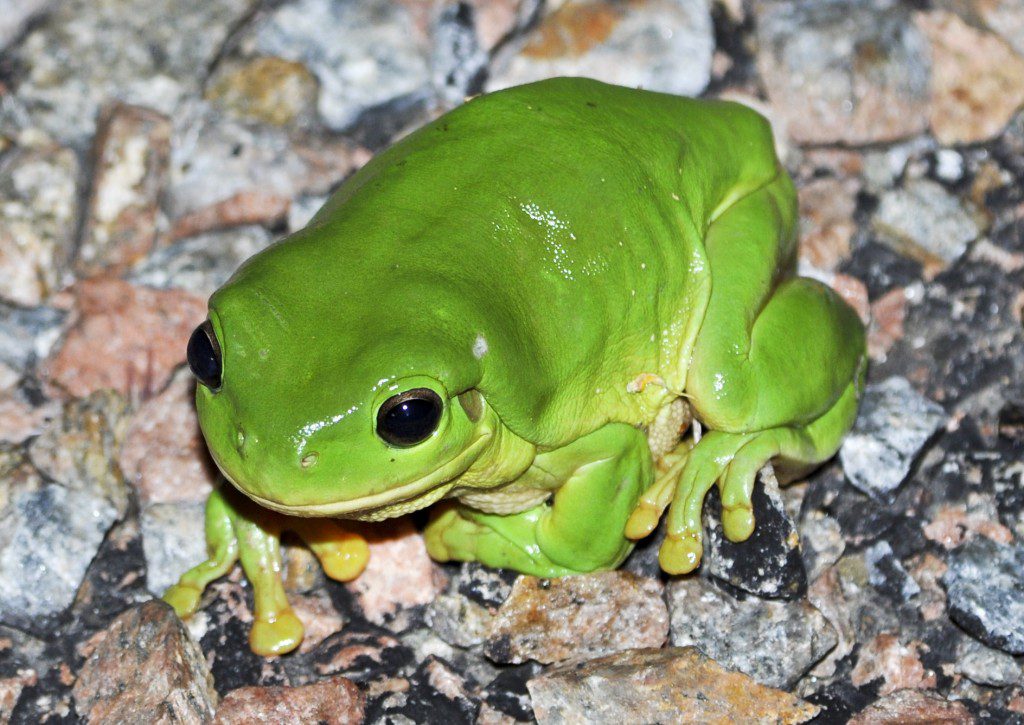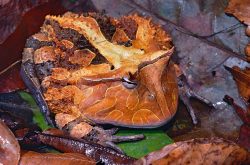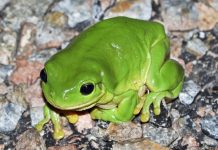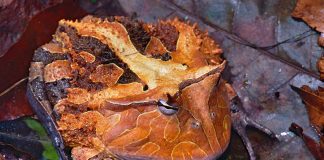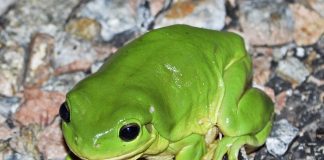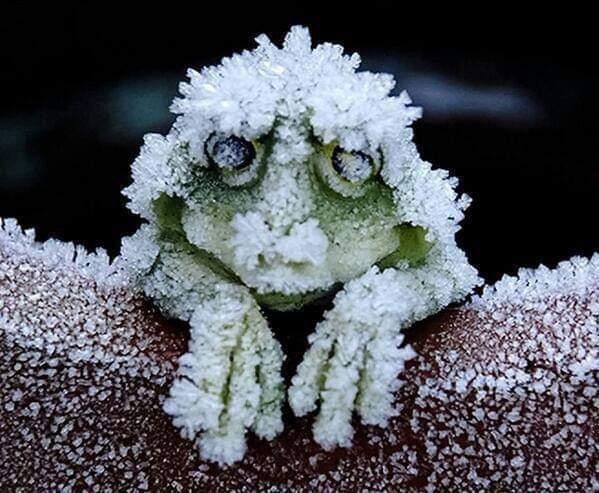
The Alaskan Wood or Tree Frog – The Anti-Freezing Frog.
The wood frog (Lithobates sylvaticus or Rana sylvatica) has a large distribution in North America, reaching from the boreal forest of the north to the southern Appalachians, with multiple distinct populations, including the area of lowland eastern North Carolina.
The wood frog has earned biologists’ study over the last century because of its freeze tolerance.
The ecology & conservation of the wood frog has attracted research attention in modern years because they are often considered “obligate” breeders in short-lived wetlands (sometimes called “vernal pools”) that are themselves more susceptible to extinction than the species that breed in them.
Wood frogs vary from 51 to 70 mm (2.0 to 2.8 in) in length. Females are larger than males. Adult wood frogs are ordinarily brown, tan, or rust-colored, & regularly have a dark eye mask. Individual frogs can alter in color. The undersides of wood frogs are pale with a yellow or green cast.
10 Alaskan Wood Frog Facts
- Alaskan wood frogs are found in the subarctic regions of Alaska and parts of Canada and Russia.
- They are one of the few species of frog that can survive in subfreezing temperatures.
- When the temperature drops below freezing, Alaskan wood frogs can enter a state of torpor, in which their body functions slow down significantly. This allows them to survive the winter months when little to no food is available.
- Alaskan wood frogs have a distinctive, two-tone coloration, with a dark brown or black back and a lighter-colored belly.
- They are small frogs, typically only growing about 2-3 inches in length.
- Alaskan wood frogs are carnivorous, feeding on insects and other small invertebrates.
- They are active during the day and are often seen basking in the sun or hopping around in search of food.
- Alaskan wood frogs are vocal frogs and can be heard calling to one another during the breeding season.
- They breed in the early spring when the temperatures begin to rise. The males will call to attract females, and once a female arrives, the male will grasp onto her with his forelegs.
- Alaskan wood frogs lay their eggs in shallow ponds or puddles, and the eggs hatch into tadpoles within a few weeks. The tadpoles then develop into adult frogs within a few months.
The Alaskan Wood Frog Description
The Alaskan wood frog (Rana sylvatica) is a small frog found in the subarctic regions of Alaska and parts of Canada and Russia. They are one of the few species of frog that can survive in subfreezing temperatures.
Alaskan wood frogs have a distinctive, two-tone coloration, with a dark brown or black back and a lighter-colored belly. They are small frogs, typically only growing about 2-3 inches in length. They have short, stocky bodies and long, thin legs.
When the temperature drops below freezing, Alaskan wood frogs can enter a state of torpor, in which their body functions slow down significantly. This allows them to survive the winter months when little to no food is available.
Alaskan wood frogs are carnivorous, feeding on insects and other small invertebrates. They are active during the day and are often seen basking in the sun or hopping around in search of food. They are vocal frogs and can be heard calling to one another during the breeding season.
The Alaskan Wood Frog Habitat
The contiguous wood frog range is from north Georgia & northeastern Canada in the east to Alaska & southern British Columbia in the west. It is the most generally distributed frog in Alaska. It is also observed in the Medicine Bow National Forest.
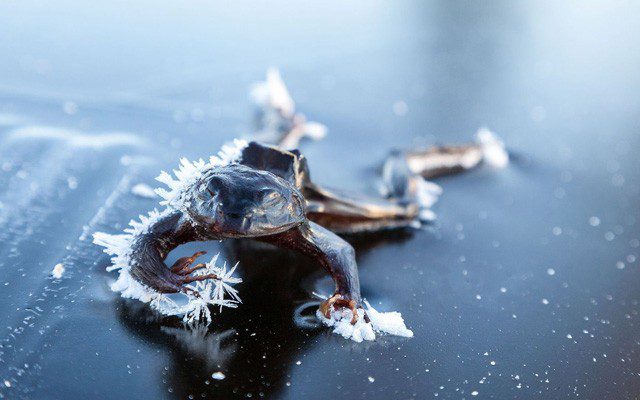 Wood frogs are forest-dwelling animals that breed primarily in ephemeral, freshwater wetlands: woodland vernal pools.
Wood frogs are forest-dwelling animals that breed primarily in ephemeral, freshwater wetlands: woodland vernal pools.
Long-distance movement plays a vital role in their life history. Individual wood frogs range broadly (hundreds of meters) amongst their breeding pools & neighboring freshwater swamps, cool-moist ravines, and/or upland localities.
Genetic neighborhoods of individual pool breeding populations increase more than a kilometer beyond the breeding site. Thus, conserving this frog species requires a landscape (multiple habitats at relevant spatial scales).
The Alaskan Wood Frog Spring mating calls
Alaskan wood frogs are known for their distinctive mating calls, which can be heard during the early spring when the temperatures begin to rise. The males will call to attract females, using a series of short, high-pitched trills.
The Alaskan Wood Frog Diet
Wood frogs eat a diversity of small, forest-floor invertebrates. Omnivorous, the tadpoles feed on plant detritus & algae & attack & eat eggs & larvae of amphibians, including wood frogs.
The wood frog’s feeding pattern, mostly similar to other frogs, is triggered by prey movement & involves a bodily lunge that closes with the mouth opening & an extension of the tongue onto the food or prey.
The frog tongue is connected to the floor of the mouth near the jaw’s tip. When the mouth is shut, the tongue lies flat, stretched behind from its point of attachment.
During the feeding strike, the tongue is swung ahead as though on a pivot, so some piece of the ordinarily dorsal & posterior tongue covering makes contact with the prey.
At this point in the feeding strike, the wood frog diverges considerably from more aquatic species, such as the green frog, leopard frog, & bullfrog. The wood frog connects with the prey with the tip of its tongue, mainly like a toad.
Cold tolerance
Like other northern frogs that enter dormancy or hibernation close to the surface in soil and/or leaf litter, wood frogs can endure the freezing of their blood & other tissues. Urea is collected in tissues preparing for the winter, & liver glycogen is turned in large quantities to glucose in response to inner ice formation.
Both urea & glucose act as anti-freezing agents (cryoprotectants) to restrict the amount of ice that builds and reduces the frog’s cells’ shrinkage.
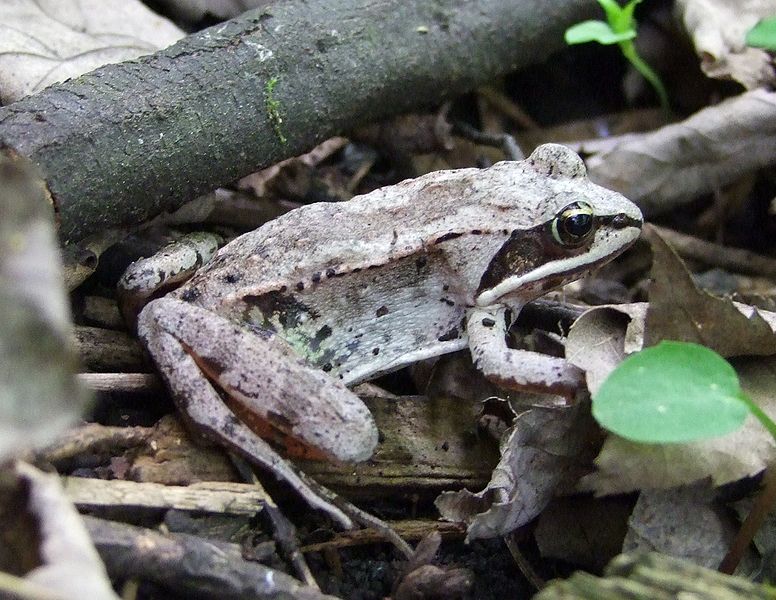
Frogs can survive many freeze/thaw episodes during winter if no more than 65% of the body of water freezes.
The Alaskan Wood Frog Reproduction
During breeding, the males will set up territories around small ponds or puddles and defend themselves from other males. When a female arrives, the male will grasp onto her with his forelegs and fertilize her eggs as she lays them in the water.
The eggs hatch into tadpoles within a few weeks, and the tadpoles then develop into adult frogs within a few months. Once the breeding season is over, the males will stop calling and the frogs will become less active, entering a state of torpor to conserve energy until the spring.
The Alaskan Wood Frog primarily breeds in temporary pools rather than continual water bodies such as ponds or lakes. This is assumed to protect the adult frogs & their offspring (eggs and tadpoles) from predators by fish & other predators of continual water bodies.
Adult wood frogs appear from hibernation in early spring and migrate to nearby pools. There, males chorus, uttering duck-like quacking sounds.
A male approaches a female & clasps from her behind & her forearms before hooking his thumbs together over her in a hold called “amplexus,” which is continued until the female lays the eggs—females lay eggs attached to the submerged under the soil, typically vegetation or branches laying on the ground.
Most commonly, females lay eggs alongside other egg clusters, creating extensive collections of groups.

Some benefit is conferred to pairs first to breed. Clutches closer to the center of the raft absorb heat & develop quicker than those on the periphery & have more shelter from predators. If pools dry before tadpoles transform into froglets, they die.
This constitutes the danger of counterbalancing the antipredator protection of temporary pools. By breeding at the start of spring, wood frogs improve their offspring’s chances of metamorphosing before pools dry out.
The larvae experience two development stages: fertilization to free-living tadpoles & free-living tadpoles to juvenile frogs. Through the first stage, the larvae are adapted for accelerated development.
Their growth depends on the temperature of the water & has a higher death rate. The second stage of growth features rapid development & growth. It depends on environmental circumstances, including food availability, temperature, & population quantity.
Following metamorphosis, a small portion (less than 20%) of juveniles will disperse, forever leaving the environment of their natal pools. The bulk of offspring tends to prevail or return to the same area, returning to their natal pool to reproduce. Most frogs reproduce only once in their lives.
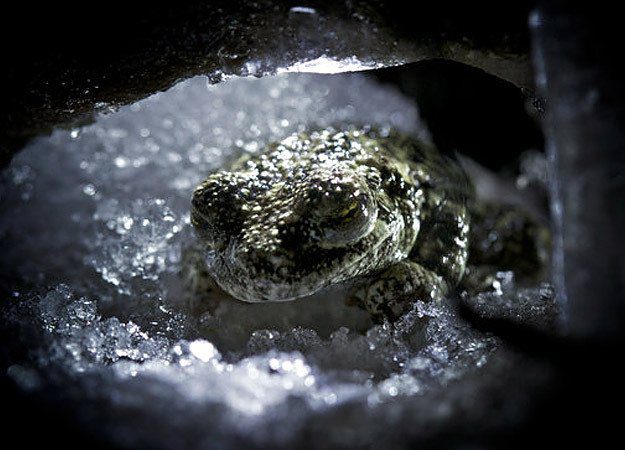
However, some will breed two or three times, usually with differences according to age. The larvae & tadpole success is essential in wood frog populations because they affect the following generations’ gene flow and genetic variation.
The Alaskan Wood Frog Conservation status
Although the wood frog is not an endangered or threatened species, several parts of its range of urbanization fragment communities. Several scientific studies have shown that under specific thresholds of forest cover loss or over specific road density thresholds, wood frogs and other common amphibians begin to “drop out” of formerly inhabited areas.
Another conservation concern is that wood frogs depend on smaller, “geographically isolated” wetlands for reproducing. In the United States, these wetlands are unprotected largely by federal law, leaving states to tackle preserving pool-breeding amphibians.
The wood frog has a complicated lifecycle that depends on multiple habitats, damp lowlands, & adjacent woodlands. Their habitat protection is, therefore, complicated, requiring combined landscape-scale preservation.
Road salt polluting freshwater ecosystems negatively influences wood frog development in the tadpole stage.
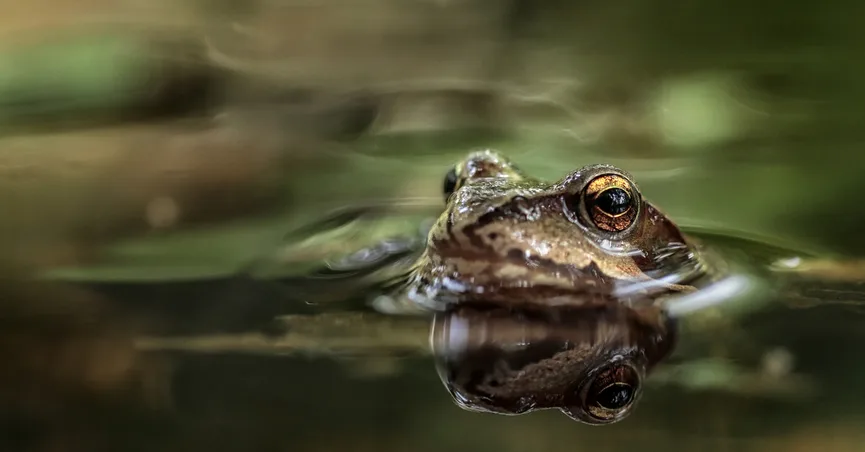
5 Alaskan tree frog adaptations
- Freeze tolerance: Alaskan wood frogs are one of the few species of frog that can survive in subfreezing temperatures. When the temperature drops below freezing, they can enter a state of torpor, in which their body functions slow down significantly. This allows them to survive the winter months when little to no food is available.
- Cold-resistant skin: Alaskan wood frogs have a special type of skin resistant to cold. This helps to prevent frostbite and other cold-related injuries.
- Thick skin and layers of fat: Alaskan wood frogs have thick skin and layers of fat that help to insulate their bodies and keep them warm in cold temperatures.
- Short, stocky bodies: Alaskan wood frogs have short, stocky bodies that are well-suited to the cold temperatures of their habitat. This body shape helps them to conserve heat and maintain a stable body temperature.
- Camouflage: Alaskan wood frogs have a two-tone coloration (dark brown or black on the back and lighter colored on the belly) that helps them to blend in with their surroundings and avoid predators.
Frequently Asked Questions About The Alaskan Wood Frog
Do Alaskan tree frogs freeze in winter?
According to a new scientific study, the wood frog of Alaska lives nearly seven months a year in a frozen state. Each September, the wood frogs of Alaska do an extraordinary thing: They freeze. They do not freeze completely solid, but they do freeze mostly solid—two-thirds of their body water changes to ice.
Can frogs live after being frozen?
When in its partially frozen state, as much as 70% of the water in a frog’s body can be frozen, write researchers Jack Layne & Richard Lee in their 1995 article in Climate Research. Frogs can survive all wintertime like this, experiencing cycles of freezing & thawing. If it gets too cold, though, they’ll die.
How does the wood frog survive winter?
Most animals that hibernate during snowy winter months have thick coats of fur or fat layers to guard them. Therefore this tiny amphibian has adjusted by freezing & thawing itself depending on the outside temperature.
Alaskan wood frog lifespan?
The Alaskan Tree or Wood Frog lives for around 3 years.
Adulthood may be reached in one to two years, depending on the sex & frog population. A wood frog’s lifespan in the wild usually is no longer than three years.
Resources
The Alaska Department of Fish and Game: This organization is responsible for managing and conserving Alaska’s fish, game, and aquatic plant resources. They may have information about the habitat, biology, and conservation of the Alaskan wood frog.






































